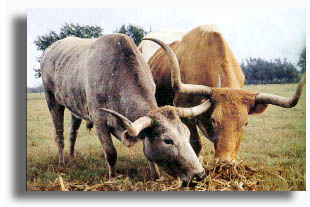Texas History:
 The only state in the Union to serve under Six
Flags: Spain, France, Mexico, the Republic Of
Texas, the Confederacy, and the United States! The only state in the Union to serve under Six
Flags: Spain, France, Mexico, the Republic Of
Texas, the Confederacy, and the United States!
Texas is a unique dominion that
draws its present-day identity from each of those
countries as well as from the ancient cultures that
preceded even the first explorers. Mexican and Native
American traditions figure prominently in the state
alongside the cultures of the Central and Eastern
European settlers who arrived much later.
Europeans were
interested in Texas as early as 1519, when Spanish conquistadores searching for
fabled cities of gold navigated the Gulf of Mexico and
disembarked on the shores of Southeast and South Texas.
Although no gleaming cities cast in gold were ever found,
the Spanish established numerous missions in South and
West Texas, including the state's earliest towns. In 1685
the French, still convinced that there was a treasure to
be uncovered, financed a colonizing expedition to the
Gulf Coast led by Sieur de La Salle. The weather,
Indians, and an unhappy crew kept La Salle from
succeeding, and the French in turn abandoned their claim
to Texas.
The Spanish continued their
missionary efforts through the 18th and the early 19th
centuries, and the territory was cultivated as ranchland
under the auspices of the Spanish government. Then, in
the 1820's, a Missouri native named Moses Austin gained
permission to establish the first Angolo colony in Texas.
His son, Stephen F. Austin, led 300 families on a successful mission
to settle the new land. In 1825 another 900 American
families arrived; 800 Mexican and European families
followed in 1831.
Colonization was going full steam
as political winds shifted farther south, forever
changing the face of the region. Mexico, which had finally won its difficult battle
for independence from Spain, lured settlers to the Texas
territory with offers of large land grants. When disputes
over ownership and religion erupted between the Texian
population (as the natives of that region were called)
and the Mexican government, another fight for
independence was on - this one for independence from
Mexico.
The Texas Revolution began with a single cannon blast in
Gonzales on October 2, 1835. In 1836 Mexico's dictator,
General Antonio Lopez Santa Anna, led troops into San
Antonio on March 6 and massacred a small band of Texians
who had holed up in the Alamo mission. Santa Anna went on
to handily defeat the Texians at the Battle of Goliad
shortly afterward. Hungry, disheartened, and short of
supplies, the dwindling Texian troops trudged on.
Finally, in a military blunder that cost him the war,
Santa Anna marched his troops straight into a surprise
attack led by General Sam Houston at San Jacinto on April
21. 1836. In a battle that lasted 18 minutes, Texas
gained its hard-won independence.
The new Republic of Texas named General
"The Raven" Sam Houston its president and Mirabeau B. Lamar its
vice president. The
republic lasted almost a decade; in 1845 it became the
28th state in the Union. The
new state was soon deluged with adventurers, fortune
seekers, and settlers, who brought with them
opportunities for growth. After a short period of peace,
Texas found itself embroiled in another war. It seceded
from the Union and joined the Confederacy in 1861.
The Civil War had
the curious effect of rejuvenating Texas' economy. Longhorn cattle  became prized for their hardy nature, and
over the two decades immediately following the Civil War,
cattle drives were a common site as cattle were rounded
up and herded across the plains to railyard shipping
points. became prized for their hardy nature, and
over the two decades immediately following the Civil War,
cattle drives were a common site as cattle were rounded
up and herded across the plains to railyard shipping
points.
Nothing in Texas'
past, however, prepared it for the change that transpired
when the Splindletop oil well blew in on January 10,
1901. The East Texas Oil Field
turned out to be massive, and wells sprang up overnight.
Further investigation revealed that much of the state sat
on oil reserves, and the race for the black gold was on.
Texas Climate
The state's southern latitude means
plenty of warm temperatures, even in deepest winter.
Weather forecasts in the Central, South, and Gulf Coast
regions can be pleasantly monotonous: sunny to partly
sunny. While summers and winters can occasionally be
extreme, spring and fall are always delightfully
moderate.
Snow occasionally makes appearances
in the Panhandle and higher elevations of the West, but
elsewhere winter tends to be little more than a nuisance.
Dramatic "blue northers" sometimes breeze
across the state, dipping temperatures as much as 25
degrees in a single hour. So enjoyable is the overall
climate in the state's southern region that it is the
winter home of a number of people who seek the shelter of
its warmth from the cold climates of Canada and the
Northeast.
Mother Nature puts on quite a show in the spring.
Roadsides and fields explode in a fantastic burst of
technicolor wonder as bluebonnets, Mexican hats, Indian
paintbrush, and delicate buttercups, to name a few, nod
gently in the breeze as if to say, "Yes, spring has
sprung!"
Autumn is no less spectacular.
Along with the pleasant nip in the air, fall brings
dramatic change in the decidous forests of Texas,
particularly in the Lost Maples State Natural Area.
Texas Geography
Four of North America's
physiographic sectors - the Rocky Mountains region, the
Great Western High Plains, the Great Western Lower
Plains, and the Gulf Coast Forested Plains - all converge
here, and the result is a geographic diversity
unparalleled in the Lower 48.
While the scrub-studded
hardscrabble of the west presents a formidable landscape,
the white sandy beaches and temperate waters of the
southeast soothe the soul. Sunsets are breathtaking as
the lingering rays hit the lunarlike Caprock in the
Panhandle, and the same sun is seldom seen through the
lush towering pines of East Texas. The rolling hills of
the Central Texas Hill Country are above the hundreds of underground
springs that course underground, filling the region's
myriad lakes with cool, clean water. Elsewhere,
mountains, deserts, plains, forests, rolling hills,
wetlands, coastal dunes, lakes, and rivers commingle to
form the singular experience that is Texas.
Texas Highway System
Nine interstate highways serve
Texas: I-10, I-20, I-27, I-30, I-35, I-37, I-40, I-44,
and I-45. Speed limits, caution areas, stops, and
directions are well marked along the 76,986 miles of
Texas Highways with more than a million signs to keep
drivers on track. Passing is illegal where there is a
continuous yellow stripe on the driver's side of the
center line. The maxium speed limit is 65 mph, but will
soon rise when the state legislature posts the new limit.
Lower speed limits are posted on all other highways and
streets.
Texas Economy
Oil is still the symbol of Texas,
along with Longhorn cattle
and, more recently, high tech. Poised on the precipice of
the 21st century, Texas embraces cattle and ranching as
critical components of the states's economy; the state
has also had phenomenal success in luring high-tech and
space engineering corporations from the East and West
coasts.
Space engineering is a natural
offshoot of NASA''s decision in the early 1960s to build
the Lyndon B. Johnson Space Center in Houston. The
high-tech and computer industries that cropped up around
NASA received support from the state's flagship
universities, and today these industries are big players
in the state's economy. Texas is headquarters for
numerous Fortune 500 companies, and it has emerged as a
leader in computer manufacturing.
Another major economic factor is
tourism and its related industries. More and more people
worldwide are discovering Texas as a vacation destination
that can reinvent itself over and over again. With
wide-open spaces as well as gleaming skyscrapers,
mysterious caverns and dramatic gorges or shopping malls
that go on forever, Texas can be any kind of vacation
destination it needs to be.
One of the newest economic areas is
the film industry. More and more film companies from the
West and East coast are flocking to Texas for its
diversified locales that can duplicate any of the
country's regions. The Texas Film Commission has become a
major player on the Third Coast. From "Giant"
to "A Perfect World", Texas is becoming the
place to film the next great movie.
Texas' must see's
Whether you enojoy perusing musty
old relics, trying on the latest in haute couture, or
conquering pristine wilderness, Texas has a place for
you. History buffs will enjoy a promenade through the
lovely old missions of San Antonio
and the Rio Grande Valley, the abandoned forts of West
Texas, and the historic battlegrounds of San Jacinto and
Goliad. Buyers will find no reason to be wary at
Houston's Galleria, San Antonio's River Walk, or Dallas' grande dame of department stores, the
original Neiman Marcus. Puzzle-solvers will find
exceptional challenges in the cryptic pictographs at
Hueco Tanks, near El Paso, and
Paint Rock, near San Angelo.
An abundance of freshwater lakes
and rivers and 624 miles of Gulf coastline provide
endless opportunities for a splashing good time in the
sun. Fishing is a year-round diversion throughout the
state, and numerous Gulf Coast communities offer chances
for exciting sport-fishing excursions. Mother Nature's
natural beauty beams through in unusual formations such
as Enchanted
Rock near Fredericksburg
and the majestic Davis Mountains of West Texas. Though Big Bend National Park is a little remote, it is also well worth
tthe effort to see it. If camping at one of the numerous
state parks is on your agenda, you can reserve a campsite
at any of them by calling (512)389-8900.
Endangered species are prevalent in
Texas, the most famous probably being the whooping
cranes, which for years have been flocking to Aransas
Wildlife Refuge to winter in the mild Texas climate. All
kinds of unusual flora and fauna can also be found by
patient visitors to the Big Thicket National Preserve
north of Beaumont. |


